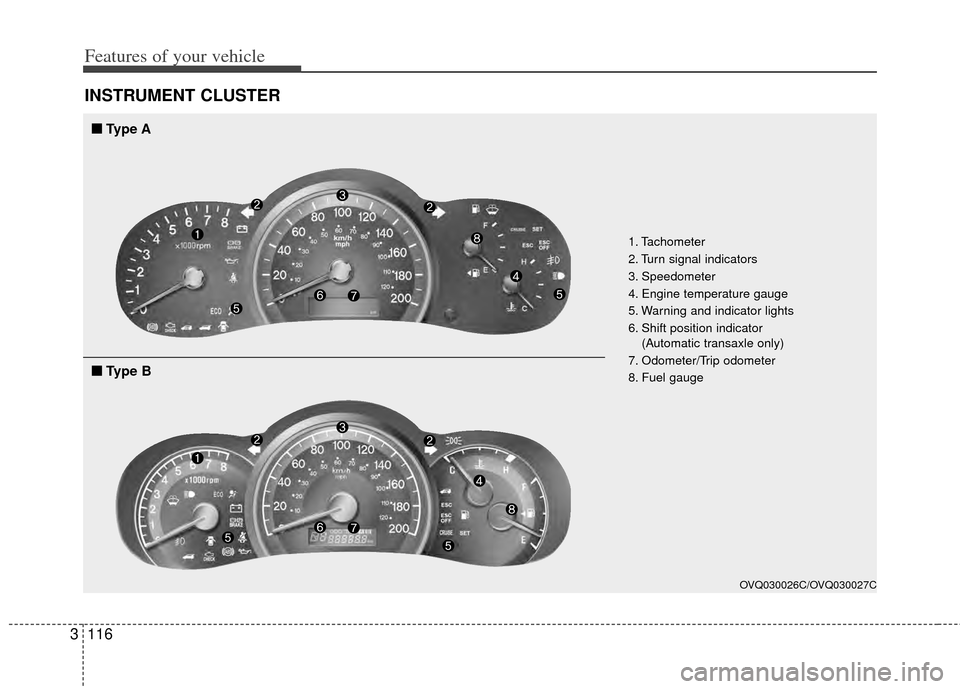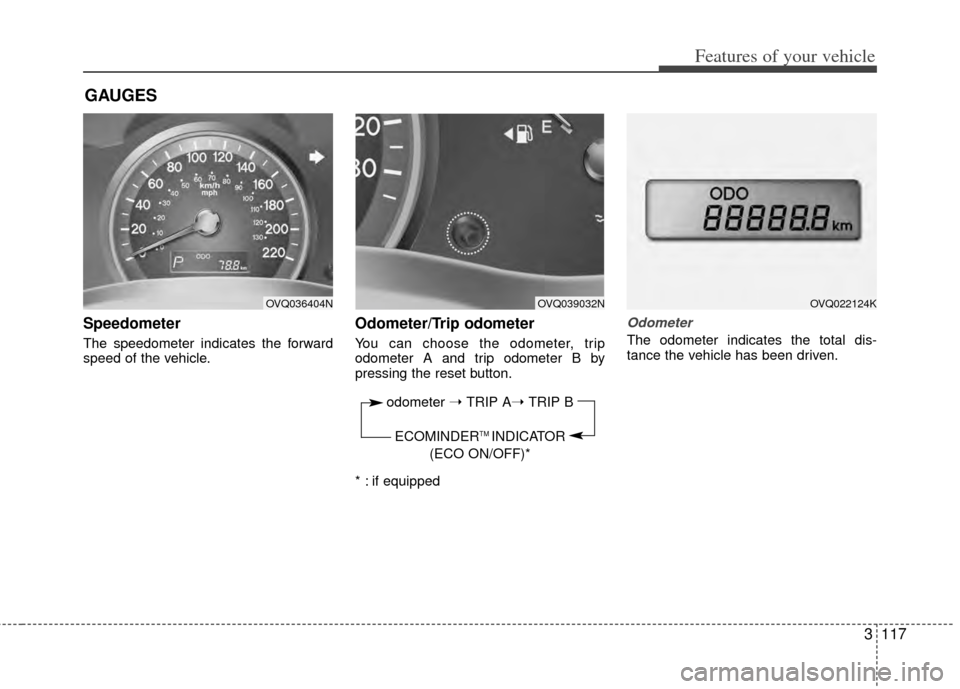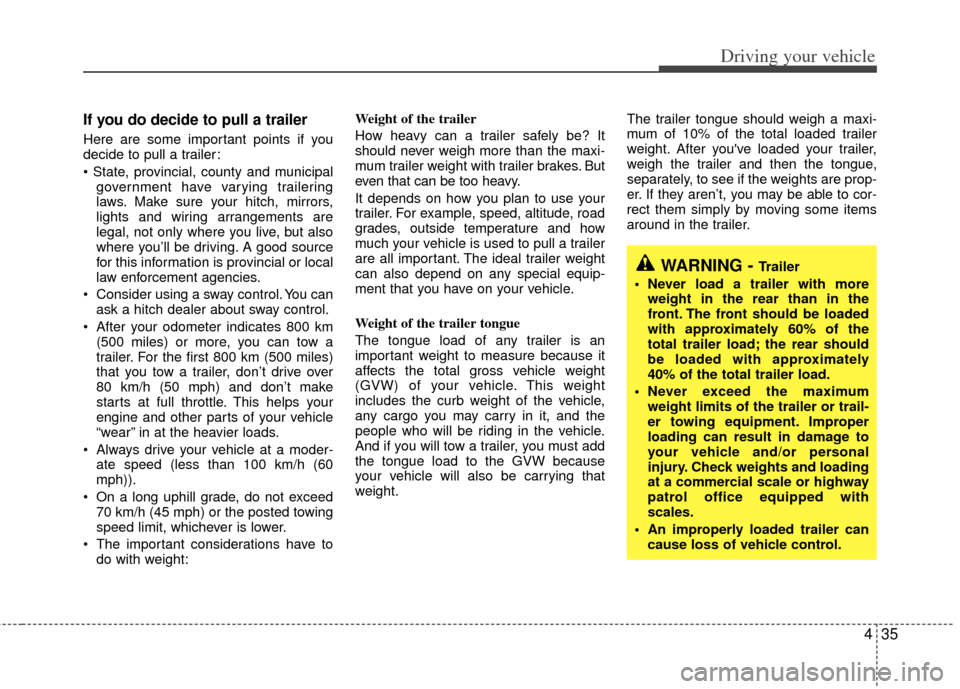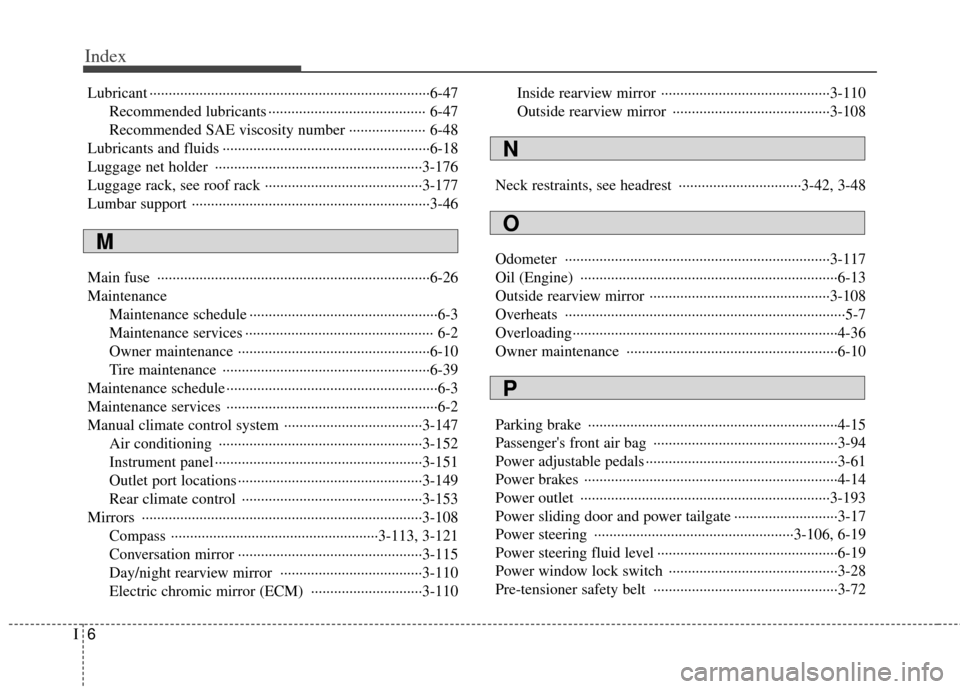2014 KIA Sedona odometer
[x] Cancel search: odometerPage 125 of 382

Features of your vehicle
116
3
INSTRUMENT CLUSTER
1. Tachometer
2. Turn signal indicators
3. Speedometer
4. Engine temperature gauge
5. Warning and indicator lights
6. Shift position indicator
(Automatic transaxle only)
7. Odometer/Trip odometer
8. Fuel gauge
OVQ030026C/OVQ030027C
■ ■ Type A
■
■Type B
Page 126 of 382

3117
Features of your vehicle
Speedometer
The speedometer indicates the forward
speed of the vehicle.
Odometer/Trip odometer
You can choose the odometer, trip
odometer A and trip odometer B by
pressing the reset button.
* : if equipped
Odometer
The odometer indicates the total dis-
tance the vehicle has been driven.
GAUGES
OVQ036404NOVQ039032N
odometer ➝ TRIP A➝ TRIP B
ECOMINDER
TM INDICATOR
(ECO ON/OFF)*
OVQ022124K
Page 127 of 382

Features of your vehicle
118
3
Trip odometer
TRIP A: Trip odometer A
TRIP B: Trip odometer B
The trip odometer indicates the distance
of individual trips selected by the driver.
Trip odometer A and B can be reset to 0
by pressing the reset button for 1 second
or more, and then releasing.
ECOMINDERTM INDICATOR
ECO ON/OFF mode (if equipped)
You can turn the ECOMINDERTMindica-
tor (which is identified on your instrument
dashboard by the “ECO” name) on/off on
the instrument cluster in this mode.
If you push the TRIP button more than 1
second in the ECOMINDER
TM indicator
ECO ON mode, then ECO OFF is dis-
played in the screen and the ECO indica-
tor turns off.
If you want to display the ECOMINDER
TM
indicator ECO again, press the TRIP but-
ton more than 1 second in the ECO OFF
mode and then ECO ON mode is dis-
played in the screen.
When you press the TRIP button less
than 1 second in the ECO mode, the
mode is changed to odometer.
Tachometer
The tachometer indicates the approxi-
mate number of engine revolutions per
minute (rpm).
Use the tachometer to select the correct
shift points and to prevent lugging and/or
over-revving the engine.
The tachometer pointer may move slight-
ly when the ignition switch is in ACC or
ON position with the engine OFF. This
movement is normal and will not affect
the accuracy of the tachometer once the
engine is running.
CAUTION
Do not operate the engine within the tachometer's RED ZONE.
This may cause severe engine dam-age.
OVQ036406NOVQ020125OVQ022125
Page 293 of 382

435
Driving your vehicle
If you do decide to pull a trailer
Here are some important points if you
decide to pull a trailer:
government have varying trailering
laws. Make sure your hitch, mirrors,
lights and wiring arrangements are
legal, not only where you live, but also
where you’ll be driving. A good source
for this information is provincial or local
law enforcement agencies.
Consider using a sway control. You can ask a hitch dealer about sway control.
After your odometer indicates 800 km (500 miles) or more, you can tow a
trailer. For the first 800 km (500 miles)
that you tow a trailer, don’t drive over
80 km/h (50 mph) and don’t make
starts at full throttle. This helps your
engine and other parts of your vehicle
“wear” in at the heavier loads.
Always drive your vehicle at a moder- ate speed (less than 100 km/h (60
mph)).
On a long uphill grade, do not exceed 70 km/h (45 mph) or the posted towing
speed limit, whichever is lower.
The important considerations have to do with weight: Weight of the trailer
How heavy can a trailer safely be? It
should never weigh more than the maxi-
mum trailer weight with trailer brakes. But
even that can be too heavy.
It depends on how you plan to use your
trailer. For example, speed, altitude, road
grades, outside temperature and how
much your vehicle is used to pull a trailer
are all important. The ideal trailer weight
can also depend on any special equip-
ment that you have on your vehicle.
Weight of the trailer tongue
The tongue load of any trailer is an
important weight to measure because it
affects the total gross vehicle weight
(GVW) of your vehicle. This weight
includes the curb weight of the vehicle,
any cargo you may carry in it, and the
people who will be riding in the vehicle.
And if you will tow a trailer, you must add
the tongue load to the GVW because
your vehicle will also be carrying that
weight.
The trailer tongue should weigh a maxi-
mum of 10% of the total loaded trailer
weight. After you've loaded your trailer,
weigh the trailer and then the tongue,
separately, to see if the weights are prop-
er. If they aren’t, you may be able to cor-
rect them simply by moving some items
around in the trailer.
WARNING - Trailer
Never load a trailer with more weight in the rear than in the
front. The front should be loaded
with approximately 60% of the
total trailer load; the rear should
be loaded with approximately
40% of the total trailer load.
Never exceed the maximum weight limits of the trailer or trail-
er towing equipment. Improper
loading can result in damage to
your vehicle and/or personal
injury. Check weights and loading
at a commercial scale or highway
patrol office equipped with
scales.
An improperly loaded trailer can cause loss of vehicle control.
Page 378 of 382

Index
4I
Engine oil ··················\
··················\
··················\
·················6-13\
Engine overheats ··················\
··················\
··················\
········5-7
Engine temperature gauge ··················\
··················\
·······3-119
Exterior care ··················\
··················\
··················\
·············6-49
Flat tire ··················\
··················\
··················\
··················\
·····5-8Changing tires ··················\
··················\
··················\
····5-11
Compact spare tire ··················\
··················\
···············5-10
Jack and tools ··················\
··················\
··················\
·······5-8
Jacking instructions ··················\
··················\
··············5-11
Removing the spare tire ··················\
··················\
·········5-8
Storing the spare tire ··················\
··················\
··············5-9
Floor mat anchor(s) ··················\
··················\
·················3-19\
4
Fluid Brakes fluid ··················\
··················\
··················\
········6-17
Washer fluid ··················\
··················\
··················\
·······6-18
Folding the rear seat back ··················\
··················\
···········3-50
Front seat adjustment - manual ···········\
··················\
·········3-39
Front seat adjustment - power ··················\
··················\
···3-40
Front passenger’s air bag ··················\
··················\
············3-94
Fuel filler lid ··················\
··················\
··················\
············3-30
Fuel gauge ··················\
··················\
··················\
··············3-119
Fuel requirements ··················\
··················\
··················\
······1-2
Fuses ·················\
··················\
··················\
··················\
·······6-23 Fuse/relay panel description ··················\
··················\
6-26
Main fuse ··················\
··················\
··················\
············6-26 Gauges··················\
··················\
··················\
··················\
···3-117
EcominderTM indicator ··················\
··················\
·····3-118
Engine temperature gauge ··················\
··················\
··3-119
Fuel gauge ··················\
··················\
··················\
········3-119
Instrument panel illumination ··················\
··············3-120
Odometer ················\
··················\
··················\
············3-117
Speedometer ···············\
··················\
··················\
········3-117
Tachometer ················\
··················\
··················\
·········3-118
Trip odometer ··················\
··················\
··················\
····3-118
Glove box ··················\
··················\
··················\
···············3-187
Hazard warning flasher ··················\
··················\
············3-146
Hazardous driving conditions ··················\
··················\
····4-27
Headrest ················\
··················\
··················\
············3-42, 3-48
Homelink
®wireless control system ··················\
············3-178
Homelink®wireless control system with rearview
display··················\
··················\
··················\
··················\
3-182
Hood ·················\
··················\
··················\
··················\
········3-29
Horn ·················\
··················\
··················\
··················\
······3-145
How to use this manual ··················\
··················\
···············1-2
F
G
H
Page 380 of 382

Index
6I
Lubricant ··················\
··················\
··················\
··················\
·6-47Recommended lubricants ··················\
··················\
····· 6-47
Recommended SAE viscosity number ··················\
·· 6-48
Lubricants and fluids ··················\
··················\
··················\
6-18
Luggage net holder ··················\
··················\
··················\
3-176
Luggage rack, see roof rack ··················\
··················\
·····3-177
Lumbar support ··················\
··················\
··················\
········3-46
Main fuse ··················\
··················\
··················\
·················6-26\
Maintenance Maintenance schedule ··················\
··················\
·············6-3
Maintenance services ··················\
··················\
············· 6-2
Owner maintenance ··················\
··················\
··············6-10
Tire maintenance ··················\
··················\
··················\
6-39
Maintenance schedule ··················\
··················\
··················\
·6-3
Maintenance services ··················\
··················\
··················\
·6-2
Manual climate control system ··················\
··················\
3-147 Air conditioning ··················\
··················\
·················3-15\
2
Instrument panel ··················\
··················\
··················\
3-151
Outlet port locations ··················\
··················\
············3-149
Rear climate control ··················\
··················\
···········3-153
Mirrors ················\
··················\
··················\
··················\
···3-108 Compass ················\
··················\
··················\
··3-113, 3-121
Conversation mirror ··················\
··················\
············3-115
Day/night rearview mirror ··················\
··················\
·3-110
Electric chromic mirror (ECM) ··················\
···········3-110 Inside rearview mirror ··················\
··················\
········3-110
Outside rearview mirror ··················\
··················\
·····3-108
Neck restraints, see headrest ··················\
··············3-42, 3-48
Odometer ················\
··················\
··················\
·················3-11\
7
Oil (Engine) ··················\
··················\
··················\
·············6-13
Outside rearview mirror ··················\
··················\
···········3-108
Overheats ················\
··················\
··················\
··················\
···5-7
Overloading··················\
··················\
··················\
···············4-36
Owner maintenance ··················\
··················\
··················\
·6-10
Parking brake ··················\
··················\
··················\
···········4-15
Passenger's front air bag ··················\
··················\
············3-94
Power adjustable pedals ··················\
··················\
··············3-61
Power brakes ··················\
··················\
··················\
············4-14
Power outlet ··················\
··················\
··················\
···········3-193
Power sliding door and power tailgate ··················\
·········3-17
Power steering ··················\
··················\
················3-106, 6-19
Power steering fluid level ··················\
··················\
···········6-19
Power window lock switch ··················\
··················\
········3-28
Pre-tensioner safety belt ··················\
··················\
············3-72
O
P
M
N